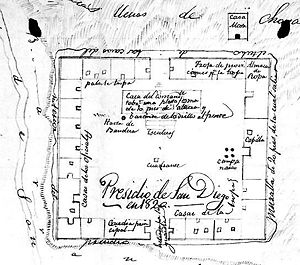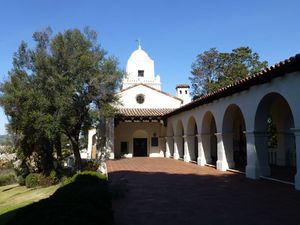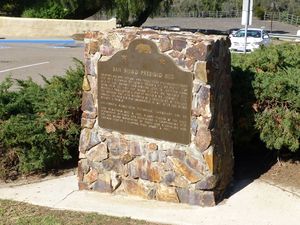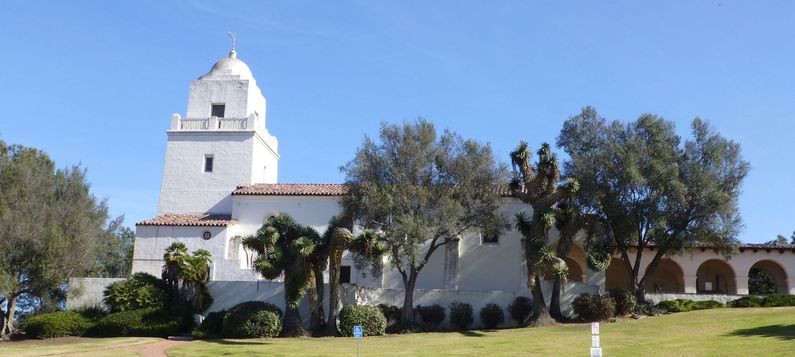Presidio of San Diego
| More information at Warlike, Wikipedia
Presidio of San Diego (1769-1831, 1846-1921) - A Spanish Presidio established in 1769 by Spanish Governor Gaspar de Portola and Fr. Junipero Serra in present day San Diego, San Diego County, California. The Presidio was abandoned by the Mexican government as a fortification in 1831. Occupied in 1846 by American forces. San Diego Depot was established in 1850 and later named Post of New San Diego and finally San Diego Barracks. San Diego Barracks was abandoned in 1921.
The Spanish Period (1769-1821) Four Spanish Presidios (Forts) were built by the Spanish Governors of California in what was known as Alta California (Upper California). The four Presidios were the Presidio of San Diego, the Presidio of Santa Barbara, the Presidio of Monterey and the Presidio of San Francisco. Each of the California Presidios was the headquarters of a military district:
Each of the Presidios had a number of missions associated with it in the surrounding military district. The Presidio was responsible for the military protection of the missions and converts but normally had only a small number of troops actually posted at each mission. The majority of the garrison remained in reserve at each presidio. The five missions associated with the Presidio of San Diego and Military District #1 were Mission San Diego de Alcala adjacent to the Presidio and Mission San Diego located about six miles to the northeast, Mission San Diego de Alcala, Mission San Luis Rey de Francia, Mission San Juan Capistrano (2) and Mission San Gabriel. A harbor fortification was built on Point Loma called Castillo de Guijarros. The Presidio was first designated a fort on 1 Jul 1769 as El Presidio Real. It was formally designated a Presidio in 1774.
The Mexican Period (1822-1846)The Mexican War of Independence ended the Spanish rule over California and changed the mission system to a more secular system with decreasing reliance on the church and the mission to provide for the native population. The Spanish Presidios of California were abandoned along with the Missions by the Mexican government starting in 1831 and allowed to deteriorate. The Mexican Government established the Presidio of Sonoma in 1836 as the military headquarters of upper California. The church and mission at San Diego continued for a while but tended mainly to the spiritual needs of the community. The mission property was eventually given to a Mexican, Santiago Arguello, in 1846. At the end of the Mexican Period neither the Presidio of San Diego nor the Castillo de Guijarros had any remaining military value. The American Period (1846-Present)The Mexican War was declared by the U.S. Congress on 11 May 1846 in response to a Mexican attack on U.S. troops in Texas. The declaration of war opened the door for American occupation of California. The American period began when American forces occupied San Diego in 1846 and built Fort DuPont (3) on Presidio Hill, later known as Garrison at San Diego, Fort Stockton (3) and Fort San Diego. The Mission San Diego de Alcala was used by a garrison of regular U.S. Army troops and named Post at Mission San Diego. San Diego Depot was established in 1850 and later named Post of New San Diego and San Diego Barracks on 5 Apr 1879. San Diego Barracks was abandoned in 1921. Current StatusNothing remains of the original Presidio, a state marker marks the site. The old Presidio site is directly in front of the more modern Junipero Serra Museum in Presidio City Park, San Diego, San Diego County, California. USGS Geographic Names Information System (GNIS) Database Entry: 247773
Links:
Visited: 17 Jan 2013 | ||||||


